BA305 Midterm 2
1/77
Earn XP
Description and Tags
Name | Mastery | Learn | Test | Matching | Spaced |
|---|
No study sessions yet.
78 Terms
Neural Networks definition
Artificial Neural Networks are flexible models used for classification, regression, and feature extraction.
Neural Networks inspiration
Mimics how neurons work in the brain by processing weighted inputs and firing signals.
Neural Networks applications
Used in areas like voice/image recognition, stock prediction, fraud detection, and self-driving cars.
Perceptron structure
Inputs (features)
Weights assigned to each input
Bias term (intercept)
Activation function
Output
Activation functions: sigmoid
smooth probability output restricted to [0,1]
Activation functions: ReLU
effective for deep learning. solves vanishing gradient problem. not differentiable at the point zero. f(x) = max{0, z}
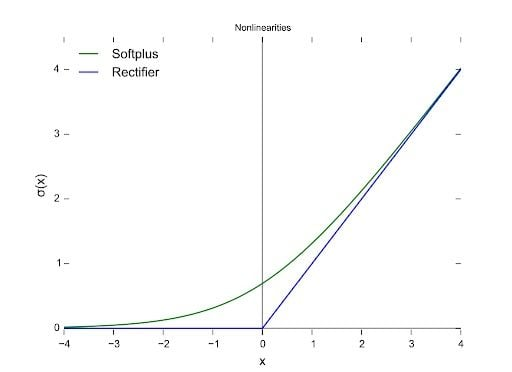
Activation functions: Step function
binary output
Activation functions: Tanh
scaled between -1 and 1
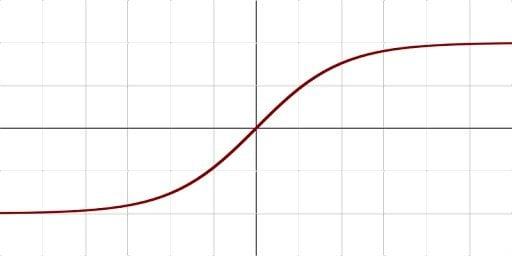
Layers of a NN:
Input layer (features)
Hidden layers (process data)
Output layer (final prediction)
Input layer
takes the features.
Hidden layers:
processes the data.
Output layer
gives the final prediction.
Deep Learning
Involves multiple hidden layers for enhanced complexity.
NN Optimization Techniques: Gradient Descent
Adjusts weights iteratively to minimize error.
NN Optimization Techniques: Backpropagation
Distributes error across layers to refine weights.
Overfitting in NNs is caused by:
Limited iterations
NN Overfitting Solution:
tracking validation error, cross-validation.
NN Data Requirements
significant computational power.
Tesla's Full Self-Driving (FSD)
Example of real-world NN implementation. Uses 48 neural networks trained with massive data and GPU hours.
Examples of NN business use cases
Consumer behavior prediction, fraud detection, and autonomous systems
NN advantages
Good predictive ability
Can capture flexible/complicated relationships between outcome and predictors
NN Disadvantages
Major danger is overfits in general
A “black box” prediction machine, with no insight into relationships between predictors and outcome
Infinite architectures to choose from…virtually infinite design space
Requires large amounts of data
No variable-selection mechanism, need to exercise care in selecting variables
Heavy computational requirements if there are many variables (additional variables dramatically increase the number of weights to calculate
Logistic regression definition
Logistic Regression (LR) is an extension of linear regression designed for classification problems.
Linear regression vs logistic regression
Linear regression predicts continuous values, while logistic regression predicts probabilities that map to discrete categories.
Logistic Regression use cases
Used for binary classification (e.g., determining whether an event occurs or not).
Sigmoid function
Ensures predictions remain between 0 and 1, making it ideal for probability modeling. y is not a target variable

Logit Model
Parameters:
'a' Coefficient: Controls the probability curve shift.
'b' Coefficient: Determines the steepness of the curve.
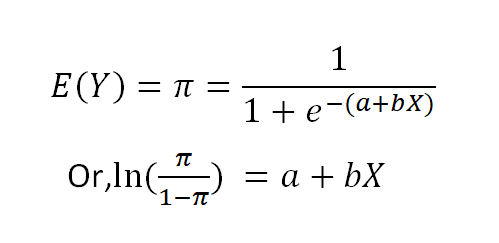
Logistic Regression optimization method
Instead of minimizing RMSE (like in linear regression), logistic regression maximizes log-likelihood, which is done automatically in Python.
Logistic Regression classification decision
Converts probability outputs into categories using a cutoff threshold (e.g., default is 0.50).
Cutoff can be adjusted to optimize accuracy, sensitivity, false positives, or cost of misclassification.
Logistic Regression Original Coefficient
Helps indicate direction of the relationship.
LogReg Exponentiated Coefficient (Odds Ratio):
Measures the magnitude of the relationship, how much odds change when the predictor variable increases by one unit.

LogReg Exponentiated Coefficient Example
If odds ratio ( e^{b} = 1.114 ), a unit increase in the independent variable increases the odds of Y=1 by 11.4%.
LogReg Considerations: Multicollinearity
Issue: Redundant predictors can cause unstable estimates.
Solution: Remove redundant variables using feature selection or data reduction methods such as Principal Component Analysis (PCA).
LogReg Considerations: Overfitting
Issue: Complex models may fit training data well but fail on validation data.
Solution: Reduce variable complexity and always use separate training/validation datasets.
LogReg p-values
p-values for predictors test null hypothesis that original coefficient = 0 (exponentiated coefficient = 1)
NN strengths
high predictive performance
can capture complicated, “non-linear” relationships between variables
Perceptron
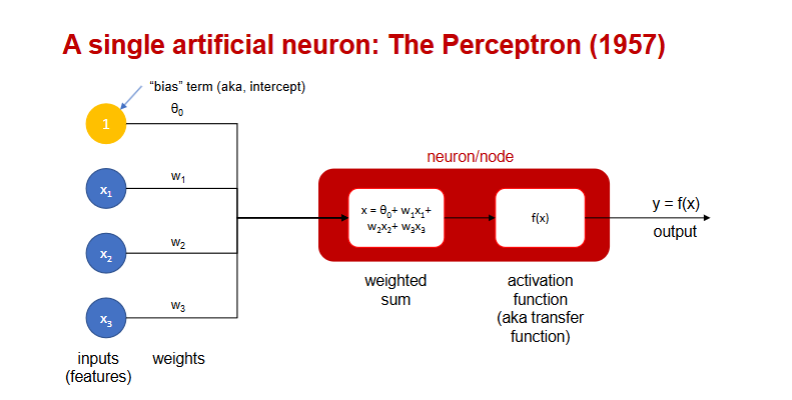
Some examples of activation functions
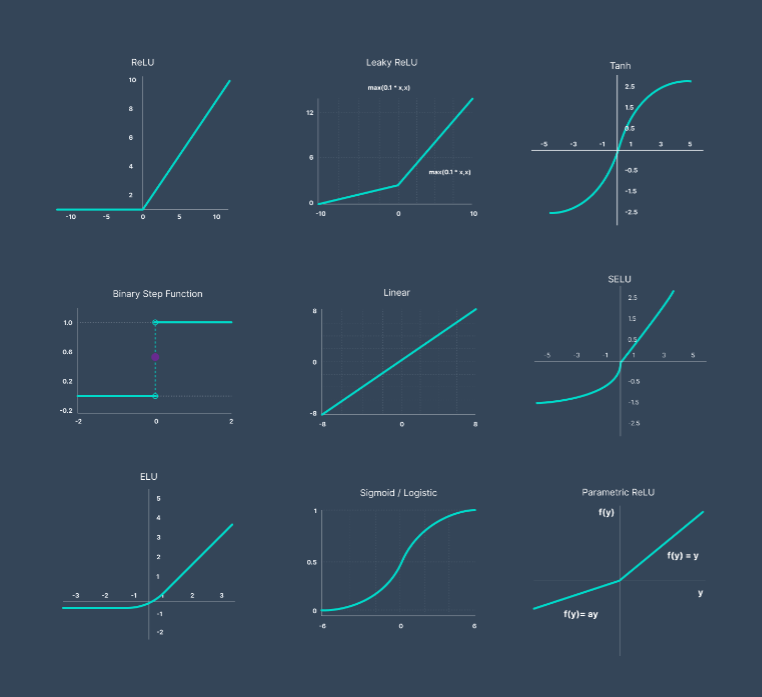
Neural network detailed description
A neural network consists of a layered, feedforward, fully connected network of perceptrons* or more advanced building blocks
Multiple layers: Input, Hidden, Output
Nodes (neurons)
“Deep learning” refers to ~3+ hidden layers
NN basic idea
Combine input information in a complex &
flexible neural network “model”
Model “coefficients” are continually tweaked
computing gradients, in an iterative local
optimization process called backpropagation
Backpropagation gets better the more iterations
you run (epochs)
NN preprocessing steps
All features are required to be numerical
Scale variables down, min-max, or standardization
Decide what is appropriate based on the nature of the activation function!
Categorical variables must be dummy coded
Iterative passes through network
At each iteration compare prediction to actual
Various types of loss functions (like RMSE) can be used to measure error
Error is propagated back and distributed to all the hidden nodes and used to update their weights
l = constant between 0 and 1, reflects the “learning rate” or “weight decay parameter”
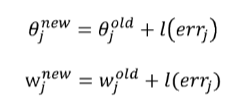
too small learning rate:
convergence extremely slow
too large learning rate:
faster learning, but may “overshoot” and fail to converge
NN Mapping the output:
E.g., in classification, output is between 0 and 1
Classification: if probability exceeds the cutoff, classify as “1”, else “0”
Prediction with metric output: Denormalization: the normalization needs to be inverted
NN Considerations: Hidden Layers
One hidden layer generally works well
NN Considerations: Number of nodes in hidden layers
More nodes capture complexity, but increase
chances of overfit
NN Considerations: Learning Rate
Low values:
Downweights the new information from errors at each iteration
Slows down learning, but reduces tendency to overfit to local structure
Learning rate: Allow the learning rate to change values as the training moves forward
At the start of training, it should be initialized to a relatively large value to allow the network to quickly approach
the general neighborhood of the optimal solution
When the network is beginning to approach convergence, the learning rate should gradually be reduced,
thereby avoiding overshooting the minimum
Logreg classification & cutoff process
Model produces an estimated probability of being a “1”, p(Y=1)
Convert to a classification by establishing cutoff level
If estimated prob. > cutoff, classify as “1”
0.50 is standard initial choice of cutoff, but not necessarily the best one
Logreg cutoff considerations
Maximize classification accuracy
Maximize sensitivity (subject to min. level of specificity)
Minimize false positives (subject to max. false negative rate)
Minimize expected cost of misclassification (need to specify costs)
Logreg odds probability

Decision tree definition
A popular ML method for prediction, like k-NN and Naïve Bayes, pioneered by Breiman et al. (1984). The output is not just a predicted result, ‘y=0’ or ‘y=1’, or a probability, p(y=1|x), but
also a set of general “rules” for why we arrived at the result
Decision trees vs K-NN
Remember for k-NN:
Collect x={ income=65,000, family members = 1, credit card balance =1000}, then find neighbors, and
determine y:{“loan default”} class (but we don’t know anything more than that)
But Trees are different: generate rules
If x={ income>60,000, family members < 2, education < PhD}, then y={“loan accept”}=0 (and we know why)
If x={ income<60,000, family members < 2, education > BS}, then y={“loan accept”}=1 (and we know why)
Decision Tree - CART
Decision trees also called Classification & Regression trees (CART)
Classification Trees: When the output represents a class, like y=‘spam’ or y=‘ham’, or y=0 or y=1
Regression Trees: When the output represents a continuous value, e.g., predicting house prices in a given area
CART trees inputs
In both cases, the inputs can be a mixture of categorical and numerical
k-NN works best with numerical inputs but can accommodate some categorical as well
Multinomial Naïve Bayes works only with categorical inputs
Gaussian Naïve Bayes (which we did not see) works best with numerical inputs
CART is more flexible
Multinomial NB
Bayes' Theorem: The algorithm uses Bayes' theorem to calculate the probability of a class given a set of features.
Feature Independence: It assumes that the presence of one feature is independent of the presence of other features, given the class.
Multinomial Distribution: It models the likelihood of features using a multinomial distribution, which is appropriate for count data.
Prediction: The algorithm predicts the class with the highest posterior probability.
Root Node
The first decision point that splits the dataset.
Decision Nodes (Internal Nodes)
Further splitting occurs based on feature values.
Leaf Nodes
Final classification or predicted value.
Majority Vote
The first step is identifying the most frequent class in the dataset.
Splitting
The dataset is split using different features (e.g., "size" or "charges") to minimize classification errors.
Example: Splitting by "charges" might yield a lower error rate than splitting by "size."
Stopping Criteria
The process stops when:
A node has zero classification mistakes (pure leaf).
There are no more features left to split on.
Error Rate
Measures the percentage of misclassified points.
Gini Impurity
Measures how mixed the classes are in a node.
Entropy
Determines the average number of yes/no questions needed for classification
Threshold Selection
Used for numerical inputs (e.g., "Size < 50" vs. "Size > 50")
Overfitting and Tree Pruning: Full Tree Issue
If grown indefinitely, trees overfit training data and perform poorly on unseen data.
Overfitting and Tree Pruning: Pruning Methods
Limit tree depth.
Set a minimum number of samples required in leaf nodes.
Complexity penalty to reduce unnecessary splits.
Random Forests definition
An ensemble method that builds multiple Decision Trees using random sampling and predictor selection
Random Forests Steps
Bootstrap sampling of training data.
Random feature selection for each tree.
Majority voting (classification) or averaging (regression) for final prediction
Random Forests Advantage
Improves accuracy while reducing overfitting
Ensemble methods
increase performance by providing several extensions to trees that combine results from multiple trees
Overfitting: Unstable Trees
Trees can also be unstable
If 2 or more variables are of roughly equal importance, which
one CART chooses for the first split can depend on the initial
partition into training and validation
A different partition into training/validation could lead to a
different initial split
This can cascade down and produce a very different tree
from the first training/validation partition
Solution is to try many different training/validation splits – k-
fold “cross validation” is going to be an important factor for
decision trees in general.
Some restrictions to limit tree growth for optimal accuracy
Maximum tree depth (longest path between the root node and the leaf node).
Minimum number of records in split nodes
Minimum number of records in terminal node
Minimum impurity increase needed to conduct a split on the next column
How to find optimal values for parameters
Use Grid or Randomized Search on training data, coupled with cross-validation
Build multiple trees using different values for the parameters, using the training fold
Measure accuracy on the holdout fold
Choose tree with best performance
Assess its performance on the validation, i.e., test data, not used at all to this point
Regression Trees - SSR
In every result “box” rather, than list the number of events “true, 1” vs “false, 0”, we instead compute the “average” value.
At each box, for every possible threshold… add up the squared residuals
The tree will (eventually) find the right splits
Regression Trees vs Linear Regression
For this type of data, linear regression underperforms (assuming right thresholds are chosen)
